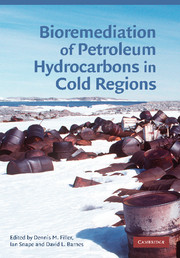Book contents
- Frontmatter
- Contents
- List of contributors
- Preface
- Glossary
- 1 Contamination, regulation, and remediation: an introduction to bioremediation of petroleum hydrocarbons in cold regions
- 2 Freezing and frozen soils
- 3 Movement of petroleum through freezing and frozen soils
- 4 Hydrocarbon-degrading bacteria in contaminated cold soils
- 5 Temperature effects on biodegradation of petroleum contaminants in cold soils
- 6 Analytical methods for petroleum in cold region soils
- 7 Treatability studies: microcosms, mesocosms, and field trials
- 8 Nutrient requirements for bioremediation
- 9 Landfarming
- 10 Thermally enhanced bioremediation and integrated systems
- 11 Emerging technologies
- References
- Index
3 - Movement of petroleum through freezing and frozen soils
Published online by Cambridge University Press: 22 August 2009
- Frontmatter
- Contents
- List of contributors
- Preface
- Glossary
- 1 Contamination, regulation, and remediation: an introduction to bioremediation of petroleum hydrocarbons in cold regions
- 2 Freezing and frozen soils
- 3 Movement of petroleum through freezing and frozen soils
- 4 Hydrocarbon-degrading bacteria in contaminated cold soils
- 5 Temperature effects on biodegradation of petroleum contaminants in cold soils
- 6 Analytical methods for petroleum in cold region soils
- 7 Treatability studies: microcosms, mesocosms, and field trials
- 8 Nutrient requirements for bioremediation
- 9 Landfarming
- 10 Thermally enhanced bioremediation and integrated systems
- 11 Emerging technologies
- References
- Index
Summary
Introduction
Movement of petroleum through non-freezing soils has been studied extensively over the last several decades. Little work has been done on understanding how petroleum moves through seasonal freezing soils (active layer) and frozen soil (permafrost). Petroleum migration through active layer and permafrost soils is influenced by the formation and presence of ice at all scales. At the millimeter scale, ice in pore spaces will either interrupt downward migration causing petroleum to spread laterally, or impede petroleum movement altogether due to the lack of open pore space. Segregated ice at centimeter-to-meter scales will most likely cause the contamination to spread laterally in frozen soils. Segregated ice formation in the active layer can also generate fissures that will enhance petroleum movement when the soil is thawed. At larger scales, discontinuous and continuous permafrost will slow, redirect, or impede contaminant migration.
Understanding the impact freezing and frozen soil conditions have on petroleum movement through soils is necessary to regulation, assessment, and cleanup of contaminated soil and groundwater. A good example of this impact is provided when considering natural attenuation. Seasonal ice and post-cryogenic structure present in active layer soil will influence the movement of petroleum and dissolved compounds, thereby impacting the design of monitoring systems to track natural attenuation. Moreover, cold soil temperatures will slow the physical weathering of compounds in the subsurface. Cleanup levels established for cold regions contaminated soil (Chapter 1) and any remediation plan developed for these sites must account for these impacts.
- Type
- Chapter
- Information
- Bioremediation of Petroleum Hydrocarbons in Cold Regions , pp. 55 - 68Publisher: Cambridge University PressPrint publication year: 2008
- 5
- Cited by



